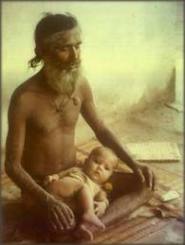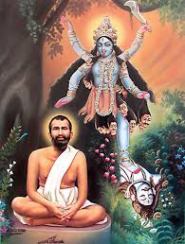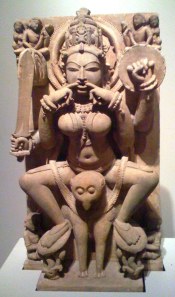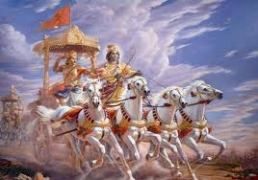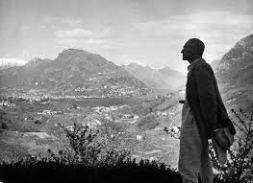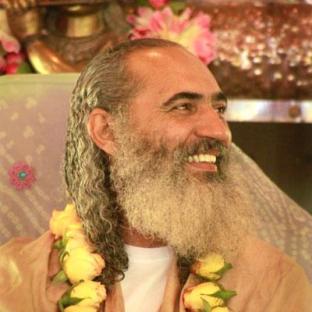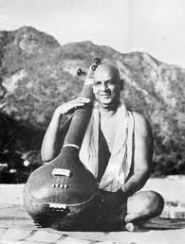‘Ramakrishna had resigned himself to the will of God with a completeness which is beyond our imagination. He was therefore incapable of making any decision except from one moment to another. Planning seemed positively horrible to him. On one occasion, it is related, he saw Hriday with a calf and asked him what he was going to do with it. ‘I’m taking it home,’ Hriday answered; ‘in a few years it’ll be full-grown and ready for the plough.’ Ramakrishna was so shocked that he fell into a swoon. When he came back to his senses, he exclaimed, ‘Look how worldly people hoard for the future! It’s only a calf now, but it will grow and work in the fields! Always planning so far ahead! Won’t they ever rely on God! Ah – that’s Maya! ‘ – from ‘Ramakrishna and his disciples’, Christopher Isherwood
The above passage about the famous 19th Century Indian mystic Ramakrishna illuminates something I have been wondering about for a while: the human need for future plans and long-term goals. I’ve often read accounts of Saints and mystics who are completely surrendered to Divine Will. They live from moment to moment, being completely receptive to what comes – and doesn’t come- their way, and are content with that. Sometimes, these mystics become so infused with ecstasy that they tear off their clothes and dance naked in the streets with tears running down their faces because they have realized who they truly are, and that beyond this, nothing actually matters.
In Glastonbury, UK, a place I visit frequently, I once made the acquaintance of a lady called Edwina. Edwina is a flamboyant character who loves wearing felt hats and travels through the world in her timeworn car. One thing that impressed me the most about her was her unwillingness to make any plans whatsoever. ‘Remember – no plans!’ she used to reprimand those who dared to ask her where she was going next, and when. She’d wake up in the mornings, listen to her guidance for the day, and live accordingly. If she felt that day to drive to a different country, then this is what she would do. If she didn’t receive adequate guidance, she stayed where she was. Another lady I came across in the same town decided to trust the Universe so completely that she gave all of her possessions, including her house and all money away, to live from moment to moment.
Yet, most of us don’t and perhaps cannot or don’t even want to live in this way. Our lives are often full of commitments and responsibilities, both imagined and real. Yet, I have a feeling that at a deeper level, much of our need for plans is really rooted in an inner insecurity. I’m not talking about a basic need for food and shelter here, though the mystics are generally so surrendered that not even this is an issue any longer. But for those of us who are not quite mystics yet, we often resist going with the flow even in small ways, such as taking a day off work to enjoy an unexpected warm, sunny day.
Few of us do follow the flow of life, and that’s actually not really surprising. Our whole system is based on living in the future, not in the now. When we’re teenagers in school, we’re already supposed to make up our minds about what career to follow and how we want to live for the rest of our lives. When we meet somebody, we already think about marriage or at least want to know if the relationship is going to last. We are told to plan for our retirements as well as for emergencies of all kinds. I’m not saying that any of this is wrong. But quite often, it also stifles our growth and sense for exploration and adventure from an early age. Because of constant planning and fear of ‘what could go wrong’, our eyes remain closed to what is around us and the endless possibilities that do exist. From experience, I can really say that the Universe generally knows best on how to bring us what is right for us. When we get in the way, we often choose the hard, arduous route based on our limited reasoning as opposed to the easy and joyful way.
But then, it all depends on what we believe the purpose of life is. If we really sit down and ask ourselves this, then what is – genuinely – the answer? Realized Masters have said for a long time that the only purpose of life is to realize who we truly are: Satchitananda – eternal bliss consciousness. But how many people in the modern world believe this? Do you believe this? Looking around, it seems more likely that we believe that the purpose of life is making sure we’re safe, both materially and emotionally, because life is so dangerous and unkind.
Rarely does a person live freely, without the trappings of ego desires and attachment. If we truly knew and trusted with every fibre of our being that we are an aspect of the Divine and that our purpose is to realize the Self, life would be very simple. We would, as Ramakrishna said, ‘rely on God’ and spend our lives in contemplation and celebration of the Divine. We’d know that our needs would be taken care of. But karma and Maya get in the way – we incarnate into this world with karmas that have to play themselves out, and on the way we get attached to illusions of security, desires and our fears of not having enough. And this is because we are steeped in ignorance as to how things truly are.
The fun of life, I feel, is uncovering that everything is an illusion. My friend Elahn Keshava, who runs Shekinashram in Glastonbury, recently put it this way: Life is like a movie screen. We believe that what we see is real, just like somebody who is engrossed in a really good movie. But then somebody shoots a hole into the movie screen, and light begins to flow through it. We become aware that actually, what we believe to be reality is not really real at all. There is a bigger reality behind it. And gradually, more and more holes start to appear in the screen until finally, it falls apart and everything is submerged in light.
You might like to read the following books – they are great accounts of spiritual personalities who have surrendered their lives completely to Divine will and had mind-blowing adventures on the way:
* ‘The Journey Home – Autobiography of an American Swami’ by Radhanath Swami
* ‘Tears of Bliss – A Guru-Disciple Mystery’ by Narvada Puri
* ‘Mere Aradhya – My Beloved Guru’ by Swami Dharmashakti Saraswati
If you enjoy my writing, my book ‘Meeting Shiva – Falling and Rising in Love in the Indian Himalayas’ is out now on Changemakers Books.
